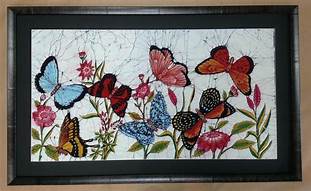Batik paintings often depicted animal or nature scenes but could picture anything. This type of painting was seen primarily in Indian and Asian areas; initially, this art form is now found all over the world.
Batik paintings have been recorded in India up to 2100 years ago and are a traditional Indonesian art that has been passed down through generations. It has also found in Egyptian tombs. In the early 1900s, Batik paintings were very fashionable in Germany and other European countries.Although modern Batik paintings use water-based paints, the ancient Batik process used vegetable dyes, wax, and cotton (or silk). After the cloth is dyed, the fabric is washed, and the starch or sized removed. At this point, the sketch of the subject is made on the material. Once the design was complete, a special wax, containing beeswax and resin, was used to fill in any areas of the sketch that would not be dyed. Once the application of wax was complete, the cloth was dipped into the desired color of dye and gently washed.


